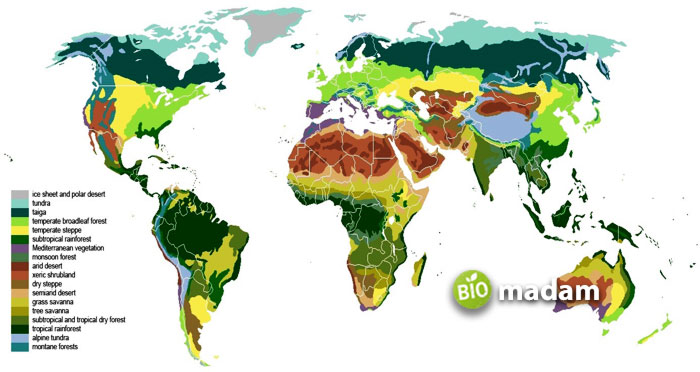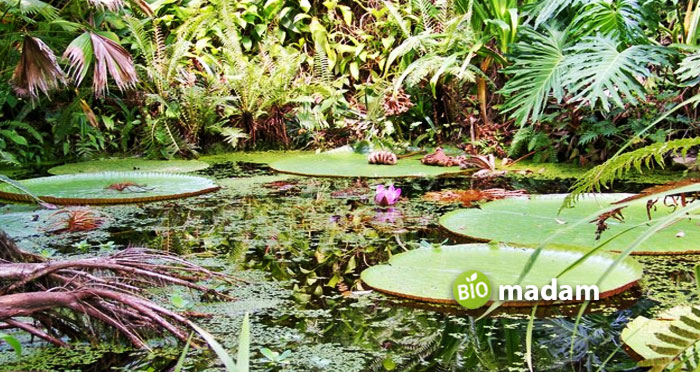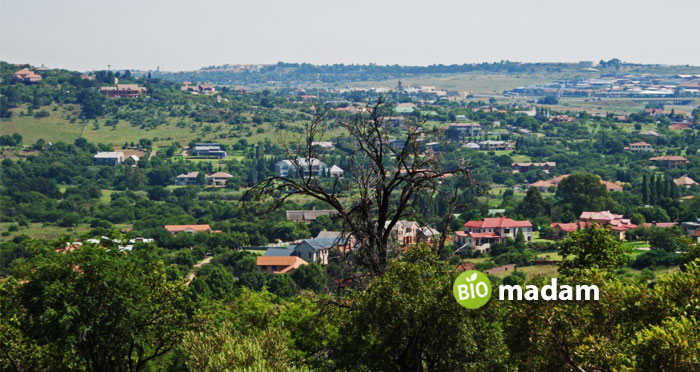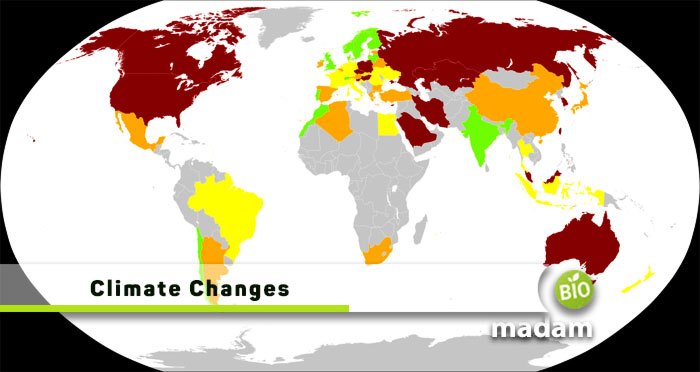Climate is an important element of our biomes and ecosystems, contributing to different processes within the surroundings. Environmental factors and organisms impact each other and their roles in the biomes. Climatic elements like sunlight and soil are essential to photosynthesis and cellular respiration, thus contributes to the sustenance of life.
Climate plays a significant role in different populations and communities in that area. The climate of a particular location at a specific period influences the routine and life cycle of organisms in that region. It may push or affect migration, reproduction, or blooming. For example, global warming is also contributing to the migration of organisms to other communities and ecosystems.
Reports also show that 28 species of birds have started nesting earlier on the United States East Coast due to the early arrival of spring. Moreover, around 16 butterfly species have arrived earlier in California, followed by the return of Northeastern birds 13 days earlier than in the previous century.
The migration of different species and subspecies in varying areas can lead to asynchronies and a fight for the available food resources. Sometimes, the organisms may migrate to another land before their food sources are present. The changes in the climate have a long-lasting impact on the lifecycles and behaviors of organisms.
Effect of Climate on Global Biomes
Disturbed Food Webs
One of the most common impacts of the climate is on food chains and food webs in specific ecosystems. The effect may start from the basics and produce a rippling result throughout the food webs. For example, when climate changes occur, they impact plants’ reproduction and development. So, the organisms that reach a particular region in a specific season might not get their food. This can lead to major changes in the food cycles over a longer period, impacting the organisms in that area.
Loss of Buffer
Nature works in mysteriously unique ways to facilitate the survival of organisms. Various elements in ecosystems and ecologies act as natural buffers to save different species from environmental hazards like flooding, drought, wildfires, etc. Changes in the climate impact extreme conditions that may increase the risks of damage to the ecosystem. Sometimes, the environmental changes are fast and irreversible when the condition passes the threshold.
Coral bleaching is a common concept to understand how buffer changes occur, leading to changes in the lives of many organisms. As the ocean temperature rises, coral reefs become stressed due to high temperatures. Eventually, they throw out the microbes that live in them, without realizing that these microorganisms, including the eubacteria and archaebacteria, are essential for normal functioning. When these microbes are washed out of their tissues, they may cause irreversible damage to the coral reefs. Stressed coral reefs often die because of coral bleaching.
Range Shift
As mentioned above, temperature changes influence migration and global organisms’ lifecycles. Many animals and plants have seen to move to higher elevations and higher latitudes with every passing decade. It allows many species to thrive in more areas but might lead to entry into less welcoming environments. When these animal or plant niches live in new habitats, they have to fight for resources, as the existing species might not be able to move elsewhere.
Many types of ecologies are facing changes due to the effect of climate on one ecosystem. For example, boreal forests are moving towards tundra, creating problems for species that cannot survive outside the tundra ecosystem. These species are not ready to leave their habitat and move into a less hospitable environment to fight for survival.

Pathogens and Diseases
Climatic changes can also spread antigens and pathogens in our surroundings, leading to more diseases. The spread is led by the movement of organisms and the microbes or pathogens they bring with them. These pathogens impact all organisms, including plants, fungi, animals, and humans. When these pathogens are not controlled in time, they can develop in vast areas and harm crops or cause diseases and infections in humans.
Extinction
Do you know why dinosaurs went extinct? Yes, you got it right. Climatic changes that disturbed the weather were the main contributor to the extinction of dinosaurs from Earth. Volcanic eruptions resulted in massive-scale climatic changes, making it difficult for dinosaurs to adjust to the changing environment. They also could not reproduce fast enough to survive a mass extinction.
The effects of climate change are not restricted to dinosaurs’ extinction. Studies show that around 20 to 30% of animal and plant species are at risk of extinction due to global warming. Species extinction rates may reach the highest at the end of this century. Rising temperature is the most prominent factor leading to difficulty in survival, followed by other elements. Biodiversity adapted to the mountain ecology is more likely to go extinct because more species are clustering at higher altitudes.
How is Climate Impacting Different Biomes?
While the impact of the climate on the environment as a whole is alarming, it can be difficult to stop the changes and their effects on organisms. Different ecosystems are affected by climatic factors in specific ways. Here is a brief look into the impact of environmental changes on various biomes and biospheres.
Tropical Biomes
Costa Rica’s tropical rainforest and leaf-cutter ants are major ecosystems influences on biomes. Leucoagaricus is a fungus that uses leaf cutter ants to collect different types of leaves where it feeds. The ants bring leaf fragments through the forest. The fungi enable the growth of small mushrooms as food for ants.
The leaf cutter ants are typically found in the tropical parts of South America, but now they are also seen in other regions. The alteration of their habitat highly influences these ants as a result of climate change. Change in temperature and humidity leads to alteration of the plants and other vegetation. It also affects the vegetation these ants rely on. The changes in the climate may also push the ant colonies to move to more habitable spaces which are not too dry or warm. Thus, they either have to face a shortage of food in their habitat or fight with organisms for survival. Sometimes, they may also act as parasites besides bacteria. The leaf-cutter ants try to take nutrients from crops, invading agricultural fields.
Another example of climatic change effect on the tropical biome is the tropical rainforests. These rainforests in South America and Central regions have over 100,000 plant species. Yet, climate change is incurring adverse effects on these forests as well. Due to temperature rises, the Costa Rican forests are becoming more stressed as a result of altered rain patterns. The changes in the state of the trees are also influencing other organisms that live in those habitats.
Forests have also experienced numerous wildfires in the past few years. While they may or may not be because of natural reasons, these wildfires have played a negative role on the organisms living in these habitats and ecosystems. These wildfires impact the environment and increase the spread of diseases. Inhabitants of nearby areas realize the harmful impacts of these incidents on their health. They also damage agricultural land.
Water Biomes
Besides tropical worlds, water biomes are also getting impacted by environmental factors. Species living in different types of biodiversity are moving towards others to save themselves from the aftermaths of changing living conditions.
Water lilies live in freshwater habitats with their roots in the mud in the waterbed. The flowers float on the water’s surface, giving the space a gorgeous look. However, water lilies react to climatic changes the same way as any other organism. Higher water temperatures lead to premature blooming of water lilies. Thus, the number of flowers is also higher than expected.
Moreover, these flowers in unusual water temperatures are smaller and do not live long. Alternatively, the leaves grow larger and become home to parasites, protozoa, and pests. The changes in water temperature also affect the functioning of the roots, resulting in compromised water uptake. Like other species, lilies may also need to migrate to distant areas to find a more suitable environment for growth. They might die if they do not adjust their life cycle accordingly or move to another space.
Another example of an aquatic organism affected by changes in climatic conditions is the Marimo moss ball. While it might not look like an apparently important part of the ecosystem, it plays a distinct role. The Marimo moss ball is a special algae, in the form of a spongy ball, typically green. This alga is typically found in freshwater lakes in Asia and Europe. Many cultures also believe that they bring good luck, but the climatic impact is also leading to changes in the habitats of Marimo moss balls. When the water bodies attain a higher temperature, they cause an increase in the reproduction of these algae. They grow faster and consume more oxygen. Thus, the levels of dissolved oxygen in the water eventually fall, increasing the population’s risk of death. It would not be an exaggeration to say that this species might go extinct if the water temperatures in their habitats keep rising.

Seasonal Biomes
Some biomes and environmental problems are seasonal. It means that climatic factors may not impact these species throughout the year. Instead, it affects these organisms in specific seasonal conditions. Some of the seasonal biome worlds impacted by climatic changes include:
Frostweed
As the name represents, Frostweed is a native North American plant adapted to frosty weather in woodlands and along roadsides. It takes up a beautiful icy look in cold temperatures leading to the formation of white crystals on the plant stems. These crystals are ice acting as an insulator to protect the plant from dying in freezing temperatures. Frostweeds are designed in a way that they can survive in cold temperatures compared to hot areas. While it is beneficial to the plant, their inability to resist high temperatures harms them. The heat waves due to higher temperatures contribute to the death of many Frostweed plants.
In the past, Frostweed plants produced flowers in October and November. The environmental changes have changed their course of reproduction and now they give flowers two months earlier. It also impacts the specie’s ability to withstand cold temperatures. Recent studies have already observed a decline in the flowering Frostweed population in the Great Plains, USA. Moreover, the flowers are of smaller size now and the plants live shorter.
Fire Lily
Fire lilies are gorgeous, captivating species that mesmerize you when you look at them. They are usually found in Asia with orange, red, and yellow flowers. These flowers appear in spring and look like burning embers. They have a distinct sweet fragrance that attracts pollinators to improve the diversity of their location. But, you might not be able to see this wonder of nature in the near future. Like the water lily, the fire lily is also another seasonal biome species in danger because of environmental changes.
Fire lilies grow in cool temperatures and avoid dry, warm areas. Fire lilies are shrinking due to increasing temperatures and inadequate growing conditions. The high temperatures often also lead to wildfires that burn all of the fire lilies in that particular habitat. Thus, fire lilies are also thought to go extinct in the coming times if the environmental changes are not managed adequately.
Desert Biomes
Opposed to common perception, desert biomes are also affected by changes in their surroundings. Plants and other organisms in desert ecosystems that do not receive the required environmental conditions are susceptible to death. Let’s discuss the example of Stapelia and Saguaro cacti.
Stapelia is a succulent native to South Africa and found in different neighboring regions. It is known for its starfish flower that resembles the hairy skin of an animal and smells like rotting meat. These flowers are large in size and have a showy appearance to attract insects for pollination and fertilization. These plants are easy to grow, yet they are influenced by climate change and find it difficult to adapt.
As discussed earlier, many organisms are moving to higher altitudes. Stapelia is one of them. Moving to higher altitudes helps these plants avoid extremely high temperatures. However, these changes still affect the flowering pattern, and the species is showing early flowering. Eventually, it disturbs the lifecycle of the plant through pollination and reproduction. The reduced rainfall has also resulted in challenges for Stapelia to survive in low irrigation areas. It is leading to the increased death rate of Stapelia plants. Yet, research also provides evidence about the distribution of this plant to other areas offering better conditions for the plant to strive and survive.
Saguaro cacti are another endangered desert species native to northwestern Mexico. While they are cacti, they can grow as high as 60 feet and live for more than 150 years. They contribute majorly to the desert ecosystem by acting as a habitat and food source for many other species.
As inhabitants of the desert ecosystem, these cacti are adapted to hot conditions and do not require low temperatures. But, they cannot survive in drought-like conditions. A higher temperature in the desert eventually leads to drought situations where these plants cannot survive. The stress caused by extremely high temperatures may cause halted growth and fewer chances of the survival of plants. The population does not grow at the same rate as in the past.
Furthermore, some areas have also seen a decline in the species. Researchers studying different branches of biology suggest that the higher mortality rates result from fewer water resources. These plants are expected to become rare with increased temperatures over time. The increase in the number of pests is also attributed to the harmful effects on Saguaro cacti.
Human Biomes
Bamboos and almond trees are among the most widely affected organisms in human biomes and ecosystems. Many species are affected by climate changes in the human biome, but bamboos are the most prominent mention. It looks like bamboo does not require any specific growing conditions, which is true as they are low-maintenance plants. They are also one of the fastest-growing plants and are found in different regions. You might not know that bamboos are quite sensitive to change and are highly impacted due to climate change.
Bamboo plants have already started dying in many parts of the world due to high temperatures and drought conditions. Opposed to droughts, extreme conditions like floods are also leading to the destruction of bamboo populations. Excess rainfall may sometimes cause the bamboo to flower earlier, causing food web disturbances as many organisms might not receive food when they migrate. The migration of other species into bamboo habitats also contributes to the wiping off of bamboo.
Besides animals, bamboo is also consumed by humans and used for economic purposes. A decline in the species or destruction of the plants on a large scale will lead to problems for people who depend on bamboo for food and income.

The Bottom Line
Our environment is changing rapidly and these changes can be studied through ecology and environmental sciences. One of the most prominent problems is the increase in temperature due to global warming. This increase in temperature throughout the world is leading to a more severe fight for survival and increased death rates. More organisms are moving towards high altitudes to save themselves from extremely hot temperatures. Thus, more species have to fight to use resources to live in a region. The biotic and abiotic factors collectively contribute to the normal functioning of an ecosystem. Thus, changes in the climate affect different biomes globally, resulting in early death and, ultimately, extinction of the species. It is necessary to take measures conserve endangered organisms of the biome as biodiversity is important for humans in terms of food, livelihood, health, and economy.

Hello, I would like to introduce myself to you! I am Chelsea Rogers, an experienced blog writer for science articles, holding an MPhil degree. My enthusiasm to grab the best knowledge, let it relate to botany, zoology, or any other science branch. Read my articles & let me wait for your words s in the comment section.

